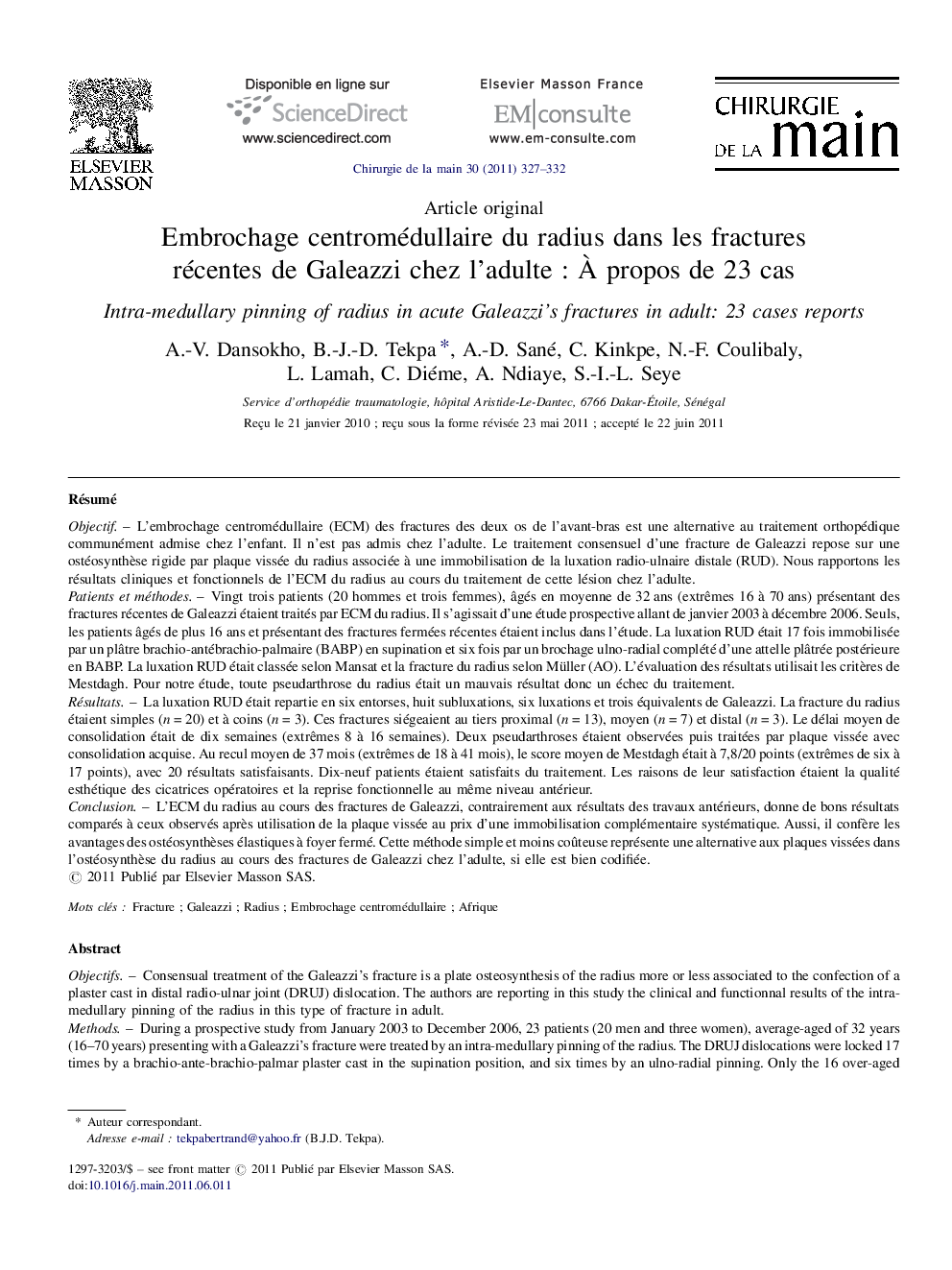| Article ID | Journal | Published Year | Pages | File Type |
|---|---|---|---|---|
| 4049391 | Chirurgie de la Main | 2011 | 6 Pages |
RésuméObjectifL’embrochage centromédullaire (ECM) des fractures des deux os de l’avant-bras est une alternative au traitement orthopédique communément admise chez l’enfant. Il n’est pas admis chez l’adulte. Le traitement consensuel d’une fracture de Galeazzi repose sur une ostéosynthèse rigide par plaque vissée du radius associée à une immobilisation de la luxation radio-ulnaire distale (RUD). Nous rapportons les résultats cliniques et fonctionnels de l’ECM du radius au cours du traitement de cette lésion chez l’adulte.Patients et méthodesVingt trois patients (20 hommes et trois femmes), âgés en moyenne de 32 ans (extrêmes 16 à 70 ans) présentant des fractures récentes de Galeazzi étaient traités par ECM du radius. Il s’agissait d’une étude prospective allant de janvier 2003 à décembre 2006. Seuls, les patients âgés de plus 16 ans et présentant des fractures fermées récentes étaient inclus dans l’étude. La luxation RUD était 17 fois immobilisée par un plâtre brachio-antébrachio-palmaire (BABP) en supination et six fois par un brochage ulno-radial complété d’une attelle plâtrée postérieure en BABP. La luxation RUD était classée selon Mansat et la fracture du radius selon Müller (AO). L’évaluation des résultats utilisait les critères de Mestdagh. Pour notre étude, toute pseudarthrose du radius était un mauvais résultat donc un échec du traitement.RésultatsLa luxation RUD était repartie en six entorses, huit subluxations, six luxations et trois équivalents de Galeazzi. La fracture du radius étaient simples (n = 20) et à coins (n = 3). Ces fractures siégeaient au tiers proximal (n = 13), moyen (n = 7) et distal (n = 3). Le délai moyen de consolidation était de dix semaines (extrêmes 8 à 16 semaines). Deux pseudarthroses étaient observées puis traitées par plaque vissée avec consolidation acquise. Au recul moyen de 37 mois (extrêmes de 18 à 41 mois), le score moyen de Mestdagh était à 7,8/20 points (extrêmes de six à 17 points), avec 20 résultats satisfaisants. Dix-neuf patients étaient satisfaits du traitement. Les raisons de leur satisfaction étaient la qualité esthétique des cicatrices opératoires et la reprise fonctionnelle au même niveau antérieur.ConclusionL’ECM du radius au cours des fractures de Galeazzi, contrairement aux résultats des travaux antérieurs, donne de bons résultats comparés à ceux observés après utilisation de la plaque vissée au prix d’une immobilisation complémentaire systématique. Aussi, il confère les avantages des ostéosynthèses élastiques à foyer fermé. Cette méthode simple et moins coûteuse représente une alternative aux plaques vissées dans l’ostéosynthèse du radius au cours des fractures de Galeazzi chez l’adulte, si elle est bien codifiée.
ObjectifsConsensual treatment of the Galeazzi's fracture is a plate osteosynthesis of the radius more or less associated to the confection of a plaster cast in distal radio-ulnar joint (DRUJ) dislocation. The authors are reporting in this study the clinical and functionnal results of the intra-medullary pinning of the radius in this type of fracture in adult.MethodsDuring a prospective study from January 2003 to December 2006, 23 patients (20 men and three women), average-aged of 32 years (16–70 years) presenting with a Galeazzi's fracture were treated by an intra-medullary pinning of the radius. The DRUJ dislocations were locked 17 times by a brachio-ante-brachio-palmar plaster cast in the supination position, and six times by an ulno-radial pinning. Only the 16 over-aged patients presenting with closed recent fractures were included in this study. The DRUJ dislocation was ranked according to Mansat, the radial fracture according to Müller (AO). The assesment of the treatment results used Mestdagh's criteria. In this study, each pseudarthrosis of the radius was considered as a failure.ResultsThe DRUJ dislocation was reparted into six sprains, eight subdislocations, and three Galeazzi's fracture equivalents. The radius fractures were simple (n = 20) or wedge fractures (n = 3). These fractures were located at the proximal third (n = 13), middle third (n = 7) and distal third (n = 3). The average consolidation delay was 10 weeks (8 to16 weeks). Two pseudarthrosis have been observed and then treated by a plate osteosynthesis. At the mean follow up of 37 months (18 to 41 months), the mean score according to Mestdagh was 7.8 points, with 20 satisfying results. Nineteen patients were satisfied by their treatment; the reasons were: the esthetic care of their scar, and the good functionnal resumption, as well as before the fracture.ConclusionThe intra-medullary pinning of radius in Galeazzi's fractures, in contrary to the previous studies, give good results compared to a plate osteosynthesis treatment. The systematic complementary lock by brachio-ante-brachio-palmar plaster cast during 3 to 4 weeks has balanced the stability defect that Mikic was reproaching to it. Moreover, it confers the benefits of elastic closed osteosynthesis. That less simple and less expensive method represents an alternative to a plate osteosynthesis in Galeazzi's fractures in adult, if it is well standardized.
